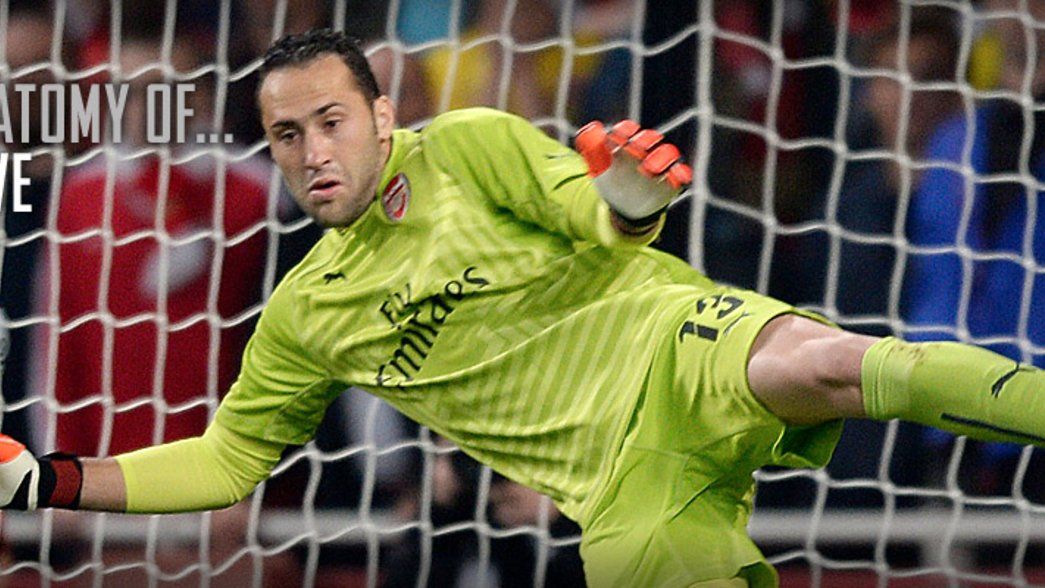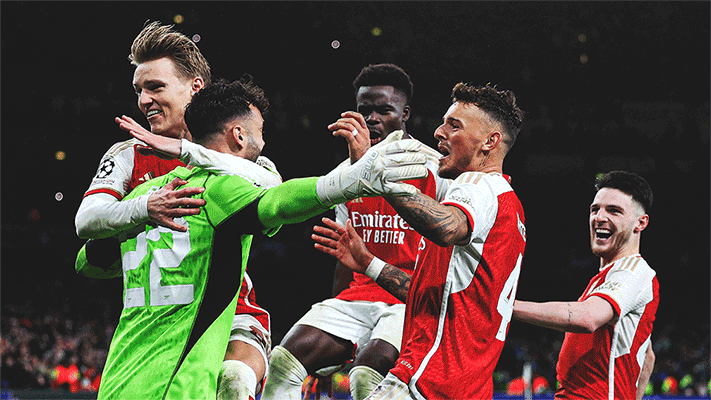Every month we bring you the complete Gunners guide to various techniques that make up the beautiful game. This month we take an in-depth look at goalkeepers’ saves.
It may well be the best save in Arsenal’s history. It might even be the greatest save of all time. But one thing is for sure, David Seaman believes it was the finest stop he ever made during a long and distinguished career between the posts.
It’s the 2003 FA Cup semi-final at Old Trafford. Arsenal are big favourites to beat struggling Sheffield United and book a third consecutive appearance in the final.
Arsenal are not at their fluent best, but Freddie Ljungberg – the FA Cup talisman – had given them a first-half lead. The decisive moment though, comes in the 84th minute. United’s Carl Asaba volleys an effort towards goal from six yards out. Diminutive striker Paul Peschisolido, lurking no more than two yards from goal, stoops and diverts Asaba’s shot away from Seaman with his head.

David Seaman saves against Sheffield United
But the veteran ‘keeper instantly changes direction and claws the ball away from goal and towards safety. It was a stunning reaction save, but one made – incredibly – at full-stretch. It combined the agility of a diving stop with the reactions of a reflex save. As commentator John Motson described it at the time: ‘breath-taking’.
“There are lots of reasons why I think that was my best save,” David begins. “At that time of my career, I was 39 and I was supposedly past it. Then I go on to make a save like that, which defied all the age scenarios and that all my reactions had gone. I remember the ball being like a pinball around the area.
"That save highlighted that I was ready for anything. I’d made one adjustment for one dive attempt, then I had to make another, and in the end I had to make another one for the actual dive"
David Seaman
“It kept going around and from side to side. People were trying to head the ball but not quite getting to it. The danger was always alive so I kept moving my body and when Peschisolido got his head on it, I remember the ball being behind me and thinking to myself that I had to go for it.
“I’ve seen some of the pictures and when you look at them, you see that the muscles in my legs are really strained and tense in trying to get to the ball. I remember getting my hand behind it and realising that it wasn’t going to stay out if it bounced off my hand, but that I would have to scoop it.
“When I scooped it out, I knew it was really close to the line. When it’s in mid air like that, you can never tell if it’s over the line or not. Obviously it wasn’t but at that moment in time you can never tell.
“I still wasn’t sure at the time but the biggest thing about the save that made sure it was remembered was that the guy who followed the rebound in blazed it over the bar. If he had put that in, nobody would have remembered the save.”
The save was the perfect way for David to mark his 1,000th senior game – including appearances for Peterborough, Birmingham, QPR and of course England. It also preserved yet another clean sheet, which was another reason why David was so pleased with it.
“That save highlighted that I was ready for anything. I’d made one adjustment for one dive attempt, then I had to make another, and in the end I had to make another one for the actual dive. The importance of it was massive because we were 1-0 up at the time and were struggling. I think everybody will agree with that.
“I’ve seen it hundreds and hundreds of times on TV,” he continues. “Every now and then it gets put out on Twitter. It’s on YouTube so people of all different ages will see it for the first time. It’s always remembered and I’ve seen it and analysed it lots and lots – even things like looking at the muscles in my leg as I was straining to get to the ball.
“I knew I’d made a good save at the time but saves can be weird. Sometimes you’ll be playing and you’ll think to yourself that you’ve made a really good save, but when you watch it back, it looks easy. That one felt a good save, and on TV it looked even better.”

David Seaman
David, who was affectionately known simply as ‘Goalie’ during his time at Arsenal, still holds the club records for most clean sheets (237) and most appearances for a ‘keeper (564). So there are plenty to choose from when it comes to other outstanding saves he made.
“I remember one that I made against Aston Villa at Highbury. It was a long time ago and it never got replayed or anything like that, but it was a shot that took a deflection. It was almost like a near-post cross. I’d gone out to dive but the deflection meant that I had to arch my left hand behind me and pull the ball away.
“I’ve never seen it on TV since. One of the more important saves that I always remember is the Scotland penalty save against Gary McAllister. It wasn’t a textbook save – it was with my elbow – but it showed that you can make saves with whatever part of your body, as long as your head is still. Even if something strange happens like a deflection, as long as you don’t panic, there is a chance that you can save it.
“I remember making the save from McAllister and Tony Adams came up to me and gave me a massive kiss, which I didn’t appreciate because he hadn’t had a shave!”

Tony Adams
So do goalkeepers remember their big saves like strikers remember their goals?
“I remember lots of saves. You also remember mistakes as well. I’m lucky in a way. I made a lot of good saves that have meant a lot in big games. One of my other favourite saves is one I made from Zola in the Cup Winners’ Cup final, when we played Parma.
“The story behind that was that around a week and a half before, we played QPR and Bradley Allen put his elbow up when I was coming for a cross and broke three of my ribs. I had to have about five painkilling injections before the Parma game just to play, and then I had another four or five at half-time to get me through the game.
“I made a great save and it was on the side where I had the broken ribs. Once I’d had the injections, it was numb – and the celebrations after the game took care of the pain!”
David adds that his favourite style of save was a reaction save. “Yeah, not ones like from long shots, where you have time to move your feet. It’s about the quick reactions. I liked them because you had to be in a set position, or in a position where you have a steady head and your focus is on the ball.
“Once you get your eyes on the ball and you follow it with your eyes, your body will react. Then it’s about how quickly your body can react after that. The key is not to panic, focus on the ball and do what you do all day in training. If you do that, everything else will take care of itself. I love seeing reaction saves because they are out of the ordinary and not ones that you are expected to make.”
The secret behind David’s incredible ability to make those stunning saves again and again was, not surprisingly, hard work. He used to train with Bob Wilson, who was Arsenal’s first dedicated goalkeeping coach.

Bob Wilson
“When we were in training, myself and Bob Wilson used to do a lot of shooting drills and you had to make what we called a ‘worldie’ to get yourself out of the drill. If you made three or four decent saves, you carried on. You had to make a great reaction save or one that you weren’t really expected to make for you to get out of goal.
“On the other side, if you went in goal and made two great saves straight away, Bob would say “that’s enough” and send you out. That was Bob’s speciality. He’d give the goalkeeper confidence, even from training. You’d go in goal, make the saves and feel great. If you stayed in for a bit longer and then made a mistake, you’d remember that instead.
“I would say about 30 per cent of goalkeeping was making saves,” he adds. “In training you have to cover everything – saves, crosses, distribution. Then you have to practise long-range shots, handling and footwork. There was a lot you had to do almost every day.
"If during a game there was a long shot that took a deflection, you’d focus more on that in the lead up to the next game. But you still had to do a bit of everything because you were never sure what was going to come in the next game. You want to be ready for anything.”

David played for the Gunners between 1990 and 2003, winning nine major honours and was widely regarded as among the very best in the world during that time. But what was the best save he’s even seen from one of his counterparts?
“I’ve got to say Gordon Banks against Pele. Even when you see it now, you still don’t know how he saves it. It looked like it was a little bit behind him because of the camera angle and for that reason, it’s hard to appreciate how good it is. He probably made it and it looks better every time he sees it on TV.
"If somebody throws a tennis ball at you, if you focus on the ball coming towards you, you will always catch it. It’s the same with football"
David Seaman
“Plus it was from Pele and not Peschisolido! When I started playing football I saw it and knew it was some save. He somehow managed to get to the back post and then flicked it up and over the post and bar. I’m sure he didn’t have any gloves on either!”
Finally, David has some valuable advice and insight for any budding young goalkeepers out there now when it comes to learning how to be a shot stopper.
“There’s a set position,” he explains. “If you’re in control, you need to have that position to save any shot or header. If you don’t tell goalkeepers where the ball is going to go, they need to be able to get to low and high shots from one position.
“You don’t know what’s going to happen. If the striker is coming in and is close to you, there’s every chance he’s going to shoot low, so you can maybe prepare yourself for that a bit more. But there’s a set position where you stand with your feet in line with your shoulders, just tilting forward a little bit with your body, and your hands level with your hips.
“It’s important to be on the balls of your feet too, and not on your heels. You need to have that to be able to make any save. You’ve got to be able to make the low saves and the highs. The other key factor is your head. If you can concentrate on the ball and pick it up as quickly as possible, and then keep focusing on it even when it’s been hit, your body will go.
If somebody throws you a tennis ball, if you don’t watch it coming into you, you’ll drop it. If somebody throws it at you, if you focus on the ball coming towards you, you will always catch it. It’s the same with football.
All-time Arsenal great saves

Bob Wilson
Bob Wilson v Manchester United
Arsenal 4, Manchester United 0
Highbury, August 22, 1970
Division One
George Best rarely missed when one-on-one with the ‘keeper, but on this occasion Bob Wilson stopped the Irishman in style. Best had gone clean through, leaving the Arsenal back four in his wake, and the great man attempted to jink past Wilson. The goalkeeper dived bravely at Best’s feet and plucked the ball off his toe. “It was a trademark Wilson save, my speciality,” said the man himself.

David Seaman saves against Sheffield United
David Seaman v Sheff United
Arsenal 1, Sheffield United 0
Old Trafford, April 13, 2003
FA Cup
Arsenal – chasing a second consecutive double – were indebted to 39-year-old David Seaman’s amazing save to win a close FA Cup semi-final. In what was the veteran’s 1,000th senior appearance, Seaman made a late, match-winning stop when he kept out Paul Peschisolido’s close-range effort. With six minutes to go, Peschisolido looked certain to score when he diverted Carl Asaba’s shot towards goal, but Seaman – off-balance – extended an arm and clawed the ball away from under the bar one-handed.

Jens Lehmann
Jens Lehmann v Villarreal
Villarreal 0, Arsenal 0
El Madrigal, April 25, 2006
UEFA Champions League
The save that sent Arsenal to their first ever Champions League final. The second leg of this Champions League semi-final was still goalless going into the last minute, meaning Arsenal would progress courtesy of the 1-0 Highbury win in the first leg. Then Gael Clichy fouled Jose Mari in the box to give the Spaniards a penalty. Up stepped Juan Roman Riquelme but Jens Lehmann flung himself to his left to deny the Argentine, and book Arsenal’s place in Paris.

Lukasz Fabianski
Lukasz Fabianski v Wigan Athletic
Arsenal 3, Wigan Athletic 0
Emirates Stadium, Nov 11, 2008
Carling Cup
Lukasz Fabianski, captaining Arse?ne Wenger’s young side, produced a stunning double-stop in the closing minutes to secure a second successive clean sheet in the competition. The Polish goalkeeper pushed aside a shot from Daniel de Ridder and then showed incredible reflexes and agility to spring up and tip Amr Zaki’s close-range effort onto the underside of the crossbar. Arguably the best save seen at Emirates Stadium to date.

Wojciech Szczesny
Wojciech Szczesny v West Bromwich Albion
West Bromwich Albion 1, Arsenal 1
The Hawthorns, October 6, 2013
Premier League
A fantastic, low diving save from Wojciech Szczesny. With a quarter of an hour gone, and the game still scoreless, Saido Berahino drifted in from the left and unleashed a powerful low shot from the edge of the area. The ball clipped off the heel of Mathieu Flamini, diverting it towards the other corner. Szczesny was heading one way but did brilliantly to adjust and keep the ball out with his right glove.
The EXPERT VIEW

Steve Morrow
Former Arsenal and Northern Ireland midfielder, Steve Morrow has also managed in America’s Major League Soccer, is a UEFA A qualified coach and has worked as a match analyst for Arsenal. com. Now head of recruitment for the Arsenal academy, he is involved with youth player development globally for the Club. I’ve been fortunate enough to work and play alongside some great goalkeepers. David Seaman here at Arsenal, Jens Lehmann and I also worked with Pat Jennings for a while when I played for Northern Ireland.
"Goalkeepers are now expected to be comfortable in possession and be able to pass the ball from the back. Just making great saves is not enough any more"
Steve Morrow
Pat and David were very similar and had all the qualities needed to be a great ‘keeper. Reaction saves are great but I think it’s all down to positioning and understanding of the game. If you get that, then you can make the saves. If you are making spectacular saves all the time you are doing something wrong, because the best goalkeepers will anticipate the danger.
When we recruit young players goalkeeping is an important part of what we do, so we are going to bring in specialist goalkeeping scouts, because it is such a specialised position.
What I look for personally when I watch goalkeepers is their physical attributes, but the most important thing is their presence. That normally tells you everything you need to know about them – their presence on the pitch, confidence and commanding the box.
I work with the goalkeeping coaches here at Arsenal, and they tell me what our scouts should be looking for. A lot of it is knowing your angles, then if you have the physical qualities to go with that, you have the agility and speed to make the important saves.
But the biggest change over the past few years is that goalkeepers are now expected to be comfortable in possession and be able to pass the ball from the back. Just making great saves is not enough any more.
The BOSS ON...

Ars
What type of saves he likes most...
I don’t necessarily link a good save with good technique. I think the best saves are the ones where you think ‘that’s a goal’ but then the ‘keeper surprises you. So it comes first from a surprise. Sometimes you have structured your brain in a certain way to expect a goal because you are thinking ‘the timing of the ball and where it’s going, that’s a goal’. So the saves that stay in the memory are when you expect a goal, but the ‘keeper still saves it. When the ‘keeper has read the game so well, he is ahead of the action and will know what will happen. Of course it’s also down to exceptional physical qualities and reflexes, but most of the time it’s down to the reading of the game and a bit of guesswork.
The best save he’s seen...
The one that stays with me is David Seaman v Sheffield United in the FA Cup. That changed the game. The ball was behind him, but he still pulled it out. It needed co-ordination of his whole body. One of David Seaman’s strengths was that he mastered every part of his body, he knew where everything was and how to use it.
The favourite goalkeeper from his youth...
Russia’s great goalkeeping legend Lev Yashin. It’s very difficult for me to say who was the best ever, because I don’t know them all well. But when I was growing up the best was always Lev Yashin, he was the star. Could you say he was the best ever? I don’t know because I didn’t see enough of him. When I played in goal when I was a kid though, I wanted to be Lev Yashin. When I played football with my brother as a kid he always put me in goal because I was five years younger than him!

Arsene Wenger
Copyright 2024 The Arsenal Football Club Limited. Permission to use quotations from this article is granted subject to appropriate credit being given to www.arsenal.com as the source.










